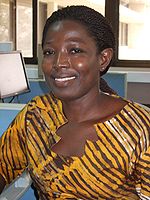User:Helen Atipoka
My name is Helen Atipoka Adongo and I am a lecturer at the department of Gur-Gonja Education at the University of education,Winneba-Ghana.
I have an MPhil in Phonetics. The topic of my thesis was spectrographic analysis of Gurene short oral vowels. I did an acoustic description of the vowels of five major dialects of Gurene.The vowels of individual speakers were described by measuring their formant frequencies. The effect of age on formants was investigated and male and female formants compared.
I am currently working on expressions in Gurene that are either prosodically or syntactically prominent and serve in some sense to establish discourse coherence or to stress what in generative grammar is referred to as 'new' information. Being in the first stage of the research, I will for the time being use the term Focus to refer to the phenomena that I am interested in.
Focus in Gurene can be marked by the particles mɛ, n, ya, ti, ni,la, kɔ’ɔmor nuuri, as well as by vowel lengthening with tone raising at the end of a word. At this point it is unclear if all these particles are really focus markers as some of them seem to have some other grammatical functions.
At present a work on a thorough description of the relevant formatives and their meaning. I will use TypeCraft for a morpheme level annotation of relevant samples of text and discourse and Praat for the phoneme level annotation.
I hope to find out the following;
1. how many of these particles are real focus markers in farefari ? 2. do all the particles claimed to be focus markers have other functions apart from marking focus?
(1)Mɛ : (a) Pɔka la dɔgɛ mɛ
Woman DEF give birth FOC
The woman has given birth
(b) Tia la lu mɛ
tree DEF fall FOC-PERF
the tree has fallen
(c) buraa la zu mɛ
MAN DEF STILL FOC-PERF
The man has stolen
(2)Ni ¬ (a) Ba nyɔkɛ ni e
they catch FOC him/her
they caught him/her
(b) Ba nyɔkɛ ni e mɛ
they catch FOC him/her FOC-PERF
they caught him/her
(c) ba ŋmɛ ni e
they beat FOC him/her
they beat him /her
(d) ba ŋmɛ ni e mɛ
they beat FOC him/her FOC-PERF
They beat him/her
(3) la (a) Pkà (b) Pká lá (c) Pká láá? Woman woman DEF-FOC woman FOC? Woman the woman the woman ? (a) kùkà (b) kùká lá (c) kúká láá? Chair chair DEF-FOC chair FOC ? chair the chair the chair ? (a) Mùì (b) Mùí lá (c) múi láá? rice rice DEF-FOC rice FOC ? rice the rice the rice ? kɔ’ɔm (4) kɔ’ɔm (i) Mam kɔ’ɔm di dia la za’a
I FOC eat food DEF all
I ate all the food
(ii) Kɔ’ɔm kina kalam kalam
FOC walk quick quick
Walk hurriedly
(5) Questions and statements in farefari
The definite article ‘‘la’’ becomes a focus marker in responses to questions. ‘‘wa’’also changes to ‘‘la’’ to mark focus. Examples are as follows ;
(1) Azuma n soi lo-katɛ la
Azuma who owns lorry-big DEF
It is Azuma who owns the big lorry
(2) Atia n sɔi loore wa? Aai, la de la Aduŋɔ dinɛ
Atia who own lorry DEF? No, FOC is Aduŋɔ own
does this lorry belong to Atia? No, it is Aduŋɔ’s
Azuma n sɔi yire la? Aai, la de la Asibi n sɔi
Azuma who own house DEF? No, FOC is Asibi own
Is the house Azuma’s ? no, it is Asibi’s
(4) Akolgo n sɔi fu mɔlega la? Aai, Akolgo fuu la de la
pɛɛlega
Akolgo who owns dress red DEF? No, Akolgo dress FOC is
white
Is the red dress Akologo’s ? No, Akologo’s dress is white
Vowel Lengthening These are also in statement and question form where we can have a statement turned to a questiion. In the questions, tone is raised and the final sound lengthen to change the statement to question and the question tag added to the end. (i) a. yì (b) n yíí? (ii) a. à yì bìà là (b) á yí biá láá? (iii) a. nykɛ buà là (b) n nykɛ buá láá? (iv) a. à dì dìà là (b) á dí diá láá? (v) a. à yè là yire (b) á yé lá yíréé? (vi) a. à kùlì mὲ (a) á kúlí mέ ?
(6) nuuri is used in constructions to emphasise on what one intends to put across. To contrast idea
Examples are ;
(i) Mam nɔŋɛ nenɔ
I like meat
(ii) Mam nuuri mam nɔgɛ la mui
I FOC I like FOC rice
As for me I like rice
(iii) Iŋa nuuri a nɔŋɛ la nyɔa
him/her FOC s/he like FOC yam
as for him/her, he/she likes yam
(iv) tumam nuuri tumam nɔŋɛ la ki
us FOC we like FOC millet
as for us , we like millet (v) bamam nuuri bamam nɔŋɛ la ziirɔ
them FOC they like FOC soup
as for they, they like soup
